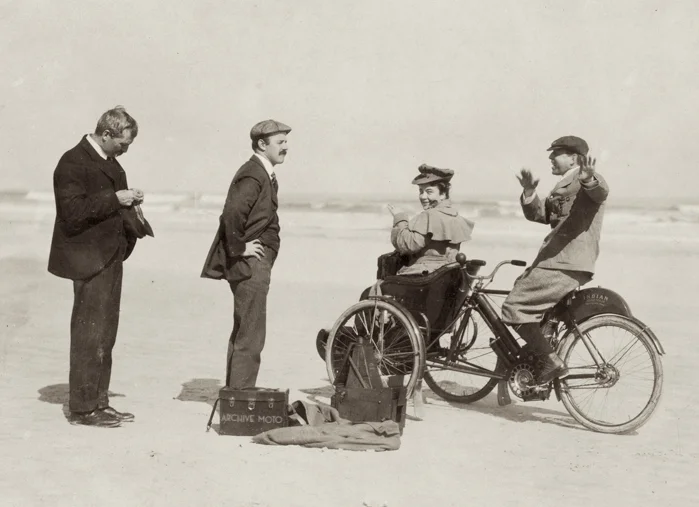Thomas K. Hastings and his lovely wife onboard their Indian Trip-Car on Ormond Beach in January 1906.
Once again the time has come, Daytona is upon us. The upcoming festivities along Florida’s east coast mean many different things to many different people, but for most headed there this week its just about good times. For me Daytona always kicks off my year of traveling to motorcycling events, and given the deep history of motorsports in the area I always look forward to the visit.
The long, wide, hard-packed stretches of sand are what brought the world’s first gear heads to the area back in 1903. That first decade of speed trails that took place in an age before speedways and salt flats established the Daytona-Ormond Beach as a capital of motorsports before the industry itself had even formed. Since, Daytona has become a point of global pilgrimage for anyone obsessed with gas and oil, from weekend warriors to icons of the sport of racing. This photograph comes from those first days on the sand at Ormond Beach, on Daytona’s north end.
New York photographer and photography supply dealer Thomas K. Hastings, and his lovely bride determined to take a bit of an adventure in January of 1906. An avid automobile enthusiast since the turn of the 20th century, Hastings had about enough of the large and finicky European touring cars by the time Oscar Hedstrom and George Hendee released their Indian Tri-Car three-wheeler in 1906. The design was relatively simple, a throwback to the earliest days of wheeled personal transportation experimentation, reintroduced to America in 1906 with the refinement that only Indian could produce. The machine was made up of a standard production model with a 3 1/2 HP engine, rigged up to a forward-facing two-wheeled, comfortably upholstered chair assembly. The front wheels were set up with coil springs on each arm as well as leaf springs underneath the chair itself to give a very comfortable ride to the motorists passenger. In an era where automobiles where still quite costly luxuries, the Tri-Car provided many with an affordable mode of motorized transportation comfortable enough for two.
Mrs. Hastings though was apparently no fan of the contraption when her husband first pulled it into his garage. However, after having prepared for a day of touring, their cumbersome automobile refused to start up and Mr. Hastings was able to convince his reluctant wife to hop onboard his Tri-Car for the outing. Apparently she was sold as much as he was with the experience, the two then began planning their adventure which would now be undertaken onboard the Indian rig instead of the automobile. The first stop on their journey was to Daytona in order to catch the speed trails that had been drawing in the motoring elite since 1903. They shipped their machine to Ormond Beach and arrived on January 22 for the start of the event.
No motorcycle races were scheduled for the 1906 Carnival of Speed. Oscar Hedstrom and Glenn Curtiss had duked it out there for the past few years, and they both would return in the coming years, but the 1906 event would prove to be all about the automobiles. This was the fastest place on earth, an age before speedways, 3 years before Indianapolis or the first of Jack Prince’s board track motordrome, and the year before the opening of Brooklands in England and the first Isle of Mann TT. For the Hastings’ Daytona was a perfect place to begin their trip by spending a few weeks, taking in the races, and touring around in their Indian Tri-Car. Mr. and Mrs. Hastings were present to take in some of the greatest automobiles of their day blasting down the beach at Ormond. The 1906 field of top class gasoline powered automobiles included the oddball Christie V4, De Dietrich, Mercedes, Darracq, Napier, Henry Ford’s 6-cyclinder K model special, and the “Freak Racer” Stanley Steamer rocket, a steam powered beast. The Steamer belonging to Louis Ross resembled more of a soap box derby car than the other machines in the field, but it stole the show that year when it was driven to a blazing 127.659 mph by Fred Merriott.
The Hastings’ trip then took them south towards West Palm Beach and then on to Miami where they loaded their three-wheeler on the steamer to Havana, Cuba. It was said on the trip that an acquaintance of the pair who was freighting his automobile to Cuba was a bit perturbed to find out how substantially less it was for the Hastings to ship the motorcycle compared to his his automobile. The total shipping costs that Thomas Hastings paid to have his Tri-Car delivered to all of their various locations from New York to Cuba and back, either by train or boat, was less than the cost to ship a car over just one leg of their journey. It was one of several advantages afforded by Indian’s Tri-Car which made it such an appealing vehicle at the time. The story goes onto describe the further irritation of the gentleman with the auto upon the groups arrival to Havana when, given the rough condition of the Cuban roads at the time, the Hastings’ zipped right on by the man and his auto, maneuvering with much greater ease along the rugged paths. After a week touring around Cuba the couple headed back to New York, shipping their trusty Indian Trip-Car after covering over 800 miles of trouble-free riding on their trip.
The photo of Mr. Hastings and his lovely wife was taken at the the start of their adventure, captured on the historic sands of Ormond Beach during the speed trails in January of 1906. Just like so many headed that way this week, the Hastings’ were just a couple of enthusiasts wanting to take in the good times to be had along the sunny coastline of Florida. Safe travels to anyone following in their tire tracks, see you there.

